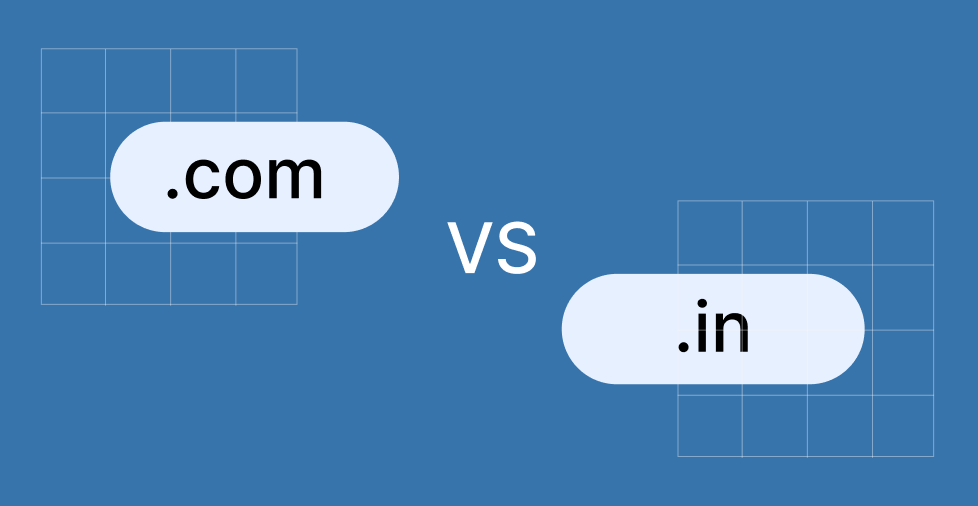Key takeaways:
- Selecting the right domain extension is vital for your business because it affects how visitors view your site, boosts its discoverability, strengthens brand consistency and professionalism.
- The primary distinction between .in and .com domain extensions lies in their varied effects on target market reach, SEO, branding, and cost.
- For businesses aiming at the Indian market, .in is an ideal domain extension.
Building a strong online presence is no small feat, and one of the first crucial decisions you’ll face is choosing the right domain extension for your website. Whether you’re leaning towards a .in or a .com, this choice can influence how well you connect with your target audience and shape your brand’s success.
In this article, we’ll explore the differences between .in and .com domain extensions and offer guidance on selecting the one that best aligns with your business goals.
What is a domain extension? Why does it matter?
A domain extension, also known as a top-level domain (TLD), is the part of a web address that comes after the main domain name, such as .com, .in, or .org. It helps to indicate the website or domain’s purpose, geographic location, or type of organization.
Choosing the right domain extension is important because it comes with benefits for your business, such as:
- It impacts how visitors perceive your website
- It makes it easier to find your webpage
- It can enhance your brand cohesion
- It makes your website appear more professional
For example, .com is widely recognized and can lend a sense of credibility. In contrast, .co might suggest a more modern or innovative brand. Additionally, some registrars offer a free domain with certain hosting plans, enabling you to secure an effective domain with little investment.
What’s the history of TLDs?
Introduced in the 1980s, TLDs started with a few generic top-level domains (gTLDs) like .com, .org, and .edu. Over time, more TLDs were created with different extensions, including country code top-level domains (ccTLDs) and domains like .in. These domain names and extensions have since become essential branding tools, helping businesses align their online presence with their target audience and market.
Specific TLDs can indirectly influence search engine optimization (SEO); for instance, country-specific TLDs domain names and extensions like .in improve local search results for India, while global TLDs domain name extensions like .com help reach a more comprehensive, international audience.
What is .in domain extension?
The .in domain is India’s country code top-level domain (ccTLD), often used for websites linked to India, such as those for educational institutions or businesses targeting the Indian market, like how .com and .net domains are used.
Advantages of .in domain extension
The .in extension comes with a host of benefits that can affect your site’s performance. Here’s what you can look forward to when applying a .in domain for your website.
- Local relevance and trust. Using a .in domain signals to visitors that your website is specifically connected to India, whether in terms of location, target market, or cultural relevance. This increases the likelihood that they will trust your brand and engage with your services or content.
- SEO benefits. Having a .in domain prompts search engines like Google to prioritize your content for Indian users or India-specific queries. This can indirectly improve your ranking in search results when potential customers in India search for related products, services, or information.
- Availability of domain names. Having a wide selection of domain names is one of the highlights of the .in extension. Thanks to its more specific niche, the .in extension offers a more diverse domain selection when compared to common TLDs like .com.
What is .com domain extension?
The .com domain, originally created and originally intended only for “commercial” use, has evolved into the most widely recognized and used domain name registrar extension globally. Its universal appeal makes it the go-to com and net domain extension of choice for businesses aiming for an international com and net presence.
Advantages of .com domain extension
Like the .in TLD, .com comes with a unique set of advantages you can leverage. Here are some benefits inherent to a .com domain:
- High credibility and recognition. People associate the .com domain with credibility and stability. This perception can enhance your brand’s reputation, making potential customers more comfortable when engaging with your site.
- Type-in traffic. A .com domain often enjoys higher type-in traffic compared to other TLDs. The familiarity and universal appeal of .com can lead to more direct visits, as people are more likely to recall and type in a .com address than a less common TLD.
What are the key differences and importance of .in and .com?
The difference between the two domain extensions, .in and .com, mainly revolves around their impact on direct their target market, SEO impact, branding considerations, and cost implications. The choice between these extensions can significantly influence how well a site attracts its target audience, supports branding, and affects the overall profitability of the business.
Here is a more detailed breakdown:
| Audience targeting and SEO impact | Branding considerations | Availability and cost implications | |
| .com | Is widely recognized and has an international audience | Is associated with a universal and established brand identity | Has less available domain names due to widespread use. Domain names often cost more than other TLDs |
| .in | Provides local SEO advantages within India and enhances the connection with a localized audience | Reinforces that your brand cares for the Indian audience | Provides a wider, and more cost-effective, selection of domain names due to a less saturated market |
.com vs .in: Which is better for SEO?
Choosing the right domain name and extension play some role in SEO as it influences how search engines and users perceive your website’s relevance. However, while choosing the right domain name and extension can provide you with SEO benefits, it’s not the most critical factor in determining your search engine rankings. The quality of your content, user experience, and the strength of your backlinks play a much larger role than your domain name extension does in how well your site performs in search results.
How to decide between .com and .in?
As important as it is to choose the right domain name and extension, it’s also important to consider your business’s goals and target audience before selecting a domain with a .com, .net, or .org extension.
A .com extension domain is ideal for:
- Global businesses
- eCommerce platforms
- eCommerce sites
- Internet service providers
- Hosting providers
- International brands that aim to reach a wide audience across multiple countries
Most users universally recognize and trust .com websites, making it the preferred choice for companies looking to establish a strong worldwide presence. Iconic websites and technology companies like Amazon.com, Google.com, and Facebook.com successfully utilize the .com domain extension to build global brands, showcasing its effectiveness in reaching a diverse and expansive audience.
However, if you’re planning to build your business targeting the Indian market, then .in is the best domain extension for you. One of the most popular extensions .in websites and online businesses in India is IRCTC, the official platform for online businesses and business websites of the Indian Railway Catering and Tourism Corporation.
How do I choose the right TLD for my brand?
To have a better idea of which TLD fits your website, you need to plan your business’s target audience and future growth. Address these features to narrow down which TLD better suits your business.
- Assess your goals and audience. Understand your target audience. If your business primarily serves a local market, choosing a country-specific TLD like .in (for India) can help you connect more closely with that audience and improve local search engine rankings. On the other hand, if your business aims to reach customers worldwide, a more universal TLD like .com might be a better choice.
- Consider your branding strategy. Consider how the domain fits with your brand. A .com domain is common and can make your business look more professional. On the other hand, a local domain can help show that you are focused on a particular region.
- Evaluate domain availability. Make sure the domain name you want is available with the TLD you’re interested in. Since .com domains are popular, many names might already be taken. You might need to look for a different domain name or consider other types of TLDs if your first choice isn’t available.
- Think long-term. Think about where you will see your business. If you plan to grow and reach people in different countries later, .com might be more suitable. But if you’re focusing on a specific area, a country-specific domain like .in could be a better fit for your long-term plans.
Register your ideal .com or .in domain today
Whether you opt for a .in or .com domain, the extension you select will play a role in shaping how on how customers perceive your brand, and how effectively you connect with them.
At Network Solutions, we offer a vast selection of domain extensions to match your specific needs. With access to a wide range of popular TLDs, including both .in and .com, Network Solutions makes it easy to find the perfect domain that aligns with your brand and goals. Start building your online presence with a domain that supports your vision and helps you connect with your audience effectively.
Frequently asked questions
The .in domain is a versatile option for anyone looking to establish a presence in India, including individuals, businesses, and organizations, while the .com domain applies more universally to most kinds of websites.
Yes, you can register a .in domain even if you’re not based in India. The .in domain is available for registration to individuals and businesses worldwide, regardless of their location.
Registering a .in or .com domain typically takes just a few minutes. Once you choose an available domain name and complete the registration process through a domain registrar, your domain should be active within a few hours, though in some cases, it may take up to 24 hours for the registration to fully propagate across the internet.
You have several options to choose from if your ideal domain name isn’t available:
1) Try a different domain extension. Consider alternative extensions like .net, .org, or country-specific ones relevant to your audience.
2) Modify your domain name. Add a keyword or try variations of your original choice that still align with your brand.
3) Check availability for purchase. Sometimes the domain owner may be willing to sell the domain. You can reach out directly or through a domain brokerage service.
4) Use a domain backorder service. If the current domain registration is set to expire, you can use a backorder service to try to claim it when it becomes available again. Backordering, also called “domain reservation”, is a service that lets you place a request to secure a domain name if it becomes available. If the current owner doesn’t renew the domain, your backorder gives you a chance to register it as soon as it’s released. It’s like being on a waitlist for the domain name you want.
Yes, people can access a .in website globally. Although the .in domain is a country code top-level domain (ccTLD) associated with India, it does not limit access.




